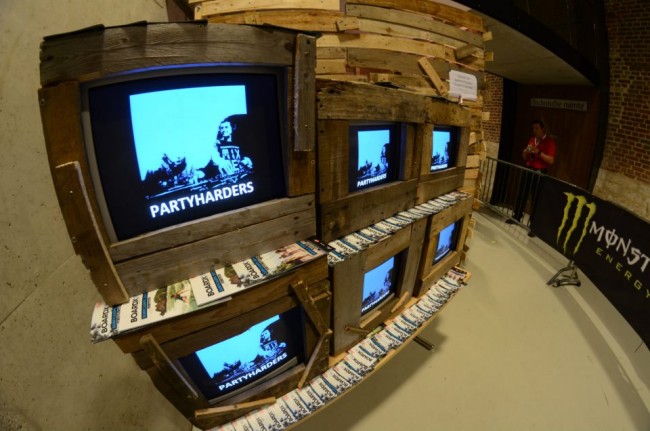He was ‘eco-friendly’ long before sustainable culture turned into a trend. He creates fascinating structures from unconventional materials such as old telephones, wood waste and different kinds of city junk. Meet the Belgian artist and designer Jeroen Boogaerts, whose extraordinary and inventive artworks have caught people’s attention and surprised with countless nostalgic references and artistic imagination.
BODEGAZ – second life to city waste
The smell of fresh-cut wood hangs in the air. The aroma of something new that is coming into the world. The scent of a dream being realized. We are in the artist’s studio of Jeroen Boogaerts ‘BODEGAZ’ in Hasselt. It is a metropolitan area surrounded by cozy cafés, bookstores and independent shops with funky, cool stuff to buy.

The word ‘bodega’ comes from the Spanish language, it means ‘grocery store.’ ‘I like local shops with personal approach, that was ‘the big idea’ when I chose the name for my artistic enterprise,’ explains the artist.
Jeroen started Bodegaz in 2010, with the intention of giving a second chance to materials that were considered by the city as waste. The designer creates unique interior objects including furniture, decoration and light sculptures. He takes all kinds of items out of their context, fixes them together and sees them again from a different perspective. ‘I believe that there are enough materials in the world and I try to recycle with what is already there in order to come up with the original concepts.’

Here, in Bodegaz, visitors can come and see with their own eyes how masterpieces are being created, to witness the craftsmanship of Boogaerts, which is beyond any machine. Moreover, no machine exists that can produce Jeroen’s opuses. As a visitor, you can also take part in workshops and meet-the-expert sessions, personally conducted by the artist.

Childhood Memories: Building Huts in the Woods of Vissenaken
The 29-year-old designer was born in the small Belgian village of Vissenaken, near by the town of Tienen, but spends his time today in the ‘micropolis’ of Hasselt, living ‘between the concept of big-city and remote rural existence.’ He elaborates: ‘I am a cosmopolitan lover of life and at the same time I enjoy regular escapes into the serene neighborhoods and parks. Hasselt is an ideal location for me, it is not too crowded and it is still a city, you get energy from it and you easily share your energy with the others and nature here.’

Jeroen’s early interest in crafts and nature was born by a fascination for everything that was beautiful and complicated. ‘When I was a small boy, I spent most of the time alone in the woods of Vissenaken, a village in the municipality of Tienen. There, in the forests, I built impressive huts right down to the smallest detail. I used the materials I found in the woods, and, of course, all kinds of junk and garbage. Another childhood memory of mine is that when I got to a toy, I always wondered: ‘How does this work?’ As a result, I opened all of my playthings with a screwdriver. Those curious investigations often ended up with me arguing with the parents. However, the quality of being curious taught me lot in life. Nowadays, if I want to make a new work, I’m always searching between waste and existing elements to obtain a new composition’.
Good Design Should Combine Function and Personality
Turning waste into art, reusing materials and being creative with them – this is Jeroen’s mission. ‘It is a life-long learning process in which you gain skills on how to change things and yourself every single day of your life. Repeating the same thing over and over again in order to get new outcomes: my everyday challenge, a task that is considered to be crazy by a lot of people who are not directly connected with arts.’ It may seem that his creations are more about fun than functionality. But this is not true. ‘I get a lot of pleasure out of doing what I do. And I guess that is evident in my work. I’m also convinced that good design should combine function and personality’.

Jeroen’s designs are original on both the visual and emotional levels, as well as the rational. At the visual level they are unordinary, curious and full of character. He devotes a lot of time to finding the right materials, objects and concepts. At the emotional level, his designs reflect the values ‘genuine, naïve and amicable.’ In other words, Boogaerts’ artwork transmits positive emotions and generates good thoughts. ‘Design needs to solve the problem and to be made for humans. I strongly believe that design should provoke emotions. It should make you smile, or feel happy, or positively nostalgic,’ says Boogaerts. Finally, there is the rational level, which is amplified in the values of hand-made quality and long-lasting value.
His trademark is constant thoughtful development, despite all the flourishing conventional commercial expansion. ‘My work is something that grants me peace in our busy everyday existence. I am surrounded by my design pieces, I move among them like in the woods of my childhood. Nice and nontrivial objects around make me constantly think, make me live.’
By Marina Kazakova
Marina Kazakova is a transmedia researcher, poetry visualizer, and a writer. She graduated from the department of Transmedia of Saint Lukas University Brussels with an art-based research thesis on ‘How to Visualize Poetry.’ Currently, she runs her own artistic production «Seanema».
]]>










